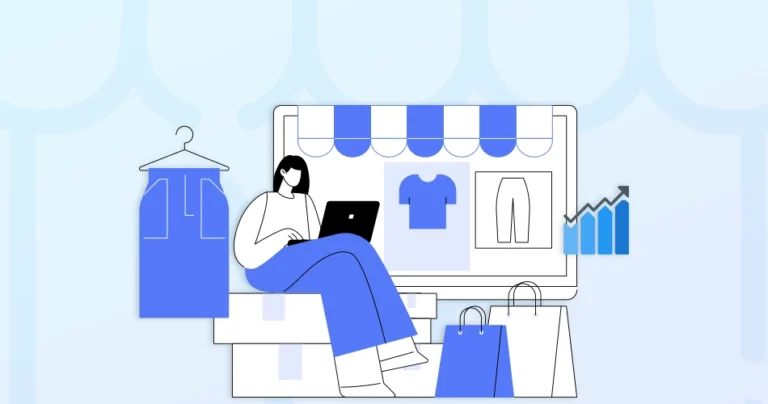One of the most popular items in online shopping is clothing, shoes, and other fashion accessories. With eCommerce, customers can scroll through the latest curated collections, comparing brands and reading reviews before a single purchase.
As for the brands, retailers, and marketers, understanding key trends is critical for staying competitive. That means everything from shifting consumer behaviors to emerging technologies. These factors have taken the fashion eCommerce industry to new levels.
This blog showcases the latest fashion eCommerce statistics, offering actionable insights into market growth fueled by the key factors. So let’s get straight into it.
Global Fashion eCommerce Statistics
The fashion eCommerce industry is undergoing rapid transformation and it’s fueled by shifting consumer habits and technological advancements. So let’s look at the eCommerce industry in numbers.
Fashion eCommerce Market Size
The global fashion eCommerce market continues its rapid expansion, driven by digital adoption and shifting consumer habits.
$780B in 2023, Doubling Soon
The market was valued at over $780B in 2023, with projections suggesting it will more than double in the coming years (Statista). This growth is fueled by increasing internet penetration, mobile shopping, and the rise of direct-to-consumer (DTC) brands.
30% of Total Fashion Retail is eCommerce
eCommerce accounts for over 21% of all fashion retail sales globally. So it is one of the most dominant eCommerce categories—second only to electronics in some regions.
Asia Leads in Fashion eCommerce Sales
Asia is the largest fashion eCommerce market, with sales expected to reach over $520B in sales by 2029. This dominance is attributed to high disposable income, strong logistics networks, and the popularity of fast fashion and luxury brands.
Consumer Behavior Shifts
Fashion shoppers are becoming more selective, influenced by convenience, sustainability, and social media.
73% Tend to Compare & Switch Brands
Over 73% of all modern shoppers browse multiple brands before making a purchase. Price, reviews, and return policies heavily influence decisions.
Good Return Policy Are Non-Negotiable
Over 15% of shoppers abandon carts if the return policy isn’t satisfactory. So retailers like Zara and ASOS have made free returns a standard to reduce cart abandonment.
Mobile Drives 70% of Fashion Sales
Smartphones dominate online purchases, with 70% of transactions occurring on mobile devices (Hootsuite). Apps and mobile-optimized sites are now essential.
Social Commerce are on the Rise
Social media platforms like Instagram, TikTok, Pinterest, and more are expected to bring 1 out of 5 eCommerce sales. Brands leverage influencer marketing and shoppable posts to capitalize on this trend.
Sustainability Matters, But Price Still Wins
While 55% of consumers prefer eco-friendly brands, only a small percentage of them are willing to pay more (Deloitte). This gap pushes brands to balance sustainability with affordability.
Emerging Technology & Personalizations
AI, AR, and chatbots are transforming how consumers shop for fashion online.
AI Recommendations Boost Conversions by 20%
Machine learning algorithms analyze browsing behavior to suggest relevant products, increasing conversion rates by 20%. Brands like Amazon and Stitch Fix use AI to personalize shopping experiences.
Chatbots Handle 65% of Pre-Purchase Queries
AI-powered chatbots resolve 65% of customer questions before human agents are needed. That reduces the response times and improves satisfaction.
AR Try-Ons Cut Returns by 25%
Virtual fitting rooms and AR try-on tools help shoppers visualize products, leading to 25% fewer returns (Retail Dive). Brands like Warby Parker and Gucci use AR to enhance confidence in purchases.
65% of Gen Z Prefers Brands with Virtual Try-Ons
Younger shoppers demand immersive experiences—65% of Gen Z actively choose brands offering AR fitting tools (Retail Dive), making this a key differentiator.
Fashion brands must prioritize mobile optimization, sustainability, and AI-driven personalization to stay competitive in this rapidly evolving market.
If you want to make the best of these statistics and take your eStore to the top, consult with our fashion eCommerce development company.
Best Practices for Fashion eCommerce Stores
To succeed in the competitive fashion eCommerce space, brands must implement a few different practices. They must optimize for user experience, leverage emerging technologies, and align with evolving consumer expectations. Here are the most effective strategies.
Optimize for Mobile-first Shopping
With fashion purchases now happening on smartphones, your mobile store isn’t just an option – it’s the main runway. Winning brands design thumb-friendly navigation, compress images for 3G speeds, and test checkout flows on actual devices.
Remember: If your site takes longer to load than a Zara changing room line, you’re losing sales.
Implement AI & Visual Search for Product Discovery
Gone are the days of ‘blue dress page 3’ searches. Modern shoppers snap and search – Pinterest reports a significant YoY increase in visual searches. Implement AI that understands “90s slip dress vibes” or “outfit like this but cheaper”. The best digital stylists don’t just find products; they decode fashion intent.
AR/VR Sizing Tools for Reducing Returns
A downside of online fashion? A high return rate mostly due to fit issues. Innovative brands now use AR mirrors that adjust for posture and body shape, not just measurements. Bonus: These virtual fitting rooms generate priceless data on how customers actually wear your clothes.
Streamline Checkout for Convenience
Your checkout process should be smoother than a stick of butter. Top performers use: 1) Address auto-complete, 2) Saved payment methods with biometric auth, and 3) Cart recovery that remembers size preferences.
Pro tip: Offer PayPal for customers who’d rather checkout than create yet another password.
Leverage Social Commerce & UGC
Instagram isn’t just your catalog – it’s your dressing room. Brands seeing success turn customer selfies into shoppable galleries, with tags showing exact colors worn in real life. The magic happens when shoppers can browse ‘outfits on actual people’ instead of stiff product shots.
Prioritize Sustainability & Transparency
Modern shoppers investigate your supply chain like a detective. Winners use interactive maps showing fabric journeys, carbon footprint calculators at checkout, and honest labels (‘This jacket took 18L water to make’). Transparency builds trust – even when your impact isn’t perfect.
Use Data-Driven Personalization
Forget ‘customers who bought this…’. Cutting-edge personalization suggests ‘Complete your capsule wardrobe’ bundles based on past purchases, or sends restock alerts when favorite items hit 30% wear in customer photos.
The goal? Make shoppers feel you understand their style better than their best friend.
You can hire Ecommerce developers to audit your store. Check it against these best practices to identify gaps and opportunities.
Wrapping Up
The fashion eCommerce industry has evolved remarkably over the last few years. It’s driven by mobile shopping, AI personalization, and rising demand for seamless, sustainable experiences.
Virtual try-ons, social commerce, and hyper-targeted recommendations reshape how consumers shop. Brands must adapt through these strategies quickly–or risk falling behind. Success will belong to those who merge data-driven strategies with authentic customer connections. So, want to build the best fashion eCommerce store? Then connect with us today!
FAQs on Fashion eCommerce
Q1. How important is mobile optimization for fashion stores?
Critical. Most shoppers browse and buy on smartphones, so a seamless mobile experience—fast loading, easy navigation, and one-click checkout—is essential.
Q2. What’s the best way to reduce cart abandonment?
Offer guest checkout, multiple payment options, free shipping thresholds, and exit-intent popups with discounts or urgency triggers.
Q3. How can AI improve fashion eCommerce?
AI enhances personalized recommendations, chatbots for instant support, visual search for product discovery, and dynamic pricing strategies.
Q4. Why should brands invest in AR/VR for fashion?
Augmented reality (AR) lets shoppers try before they buy, reducing returns and increasing confidence in purchases—especially for eyewear, makeup, and footwear.
Q5. How can small fashion brands compete with giants?
Focus on niche audiences, unique branding, exceptional customer service, and leveraging user-generated content to build authenticity.





